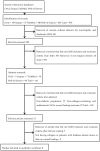Antibacterial-Integrated Collagen Wound Dressing for Diabetes-Related Foot Ulcers: An Evidence-Based Review of Clinical Studies
- PMID: 32972012
- PMCID: PMC7570079
- DOI: 10.3390/polym12092168
Antibacterial-Integrated Collagen Wound Dressing for Diabetes-Related Foot Ulcers: An Evidence-Based Review of Clinical Studies
Abstract
Diabetic foot ulcer (DFU) is a chronic wound frequently delayed from severe infection. Wound dressing provides an essential barrier between the ulcer and the external environment. This review aimed to analyse the effectiveness of antibacterial collagen-based dressing for DFU treatment in a clinical setting. An electronic search in four databases, namely, Scopus, PubMed, Ovid MEDLINE(R), and ISI Web of Science, was performed to obtain relevant articles published within the last ten years. The published studies were included if they reported evidence of (1) collagen-based antibacterial dressing or (2) wound healing for diabetic ulcers, and (3) were written in English. Both randomised and non-randomised clinical trials were included. The search for relevant clinical studies (n) identified eight related references discussing the effectiveness of collagen-based antibacterial wound dressings for DFU comprising collagen impregnated with polyhexamethylene biguanide (n = 2), gentamicin (n = 3), combined-cellulose and silver (n = 1), gentian violet/methylene blue mixed (n = 1), and silver (n = 1). The clinical data were limited by small sample sizes and multiple aetiologies of chronic wounds. The evidence was not robust enough for a conclusive statement, although most of the studies reported positive outcomes for the use of collagen dressings loaded with antibacterial properties for DFU wound healing. This study emphasises the importance of having standardised clinical trials, larger sample sizes, and accurate reporting for reliable statistical evidence confirming DFU treatment efficiency.
Keywords: antibacterial; clinical trial; collagen; diabetic ulcer; wound dressing; wound healing.
Conflict of interest statement
The authors declare no conflict of interest. The funders had no role in the design of the study; in the collection, analyses, or interpretation of data; in the writing of the manuscript, or in the decision to publish the results.
Figures
References
-
- Saeedi P., Petersohn I., Salpea P., Malanda B., Karuranga S., Unwin N., Colagiuri S., Guariguata L., Motala A.A., Ogurtsova K., et al. Global and regional diabetes prevalence estimates for 2019 and projections for 2030 and 2045: Results from the International Diabetes Federation Diabetes Atlas, 9th edition. Diabetes Res. Clin. Pract. 2019;157:107843. doi: 10.1016/j.diabres.2019.107843. - DOI - PubMed
-
- Tan W.S., Arulselvan P., Ng S.F., Taib C.N.M., Sarian M.N., Fakurazi S. Improvement of diabetic wound healing by topical application of Vicenin-2 hydrocolloid film on Sprague Dawley rats 11 Medical and Health Sciences 1103 Clinical Sciences. BMC Complement. Altern. Med. 2019;19:20. doi: 10.1186/s12906-018-2427-y. - DOI - PMC - PubMed
Publication types
Grants and funding
LinkOut - more resources
Full Text Sources


